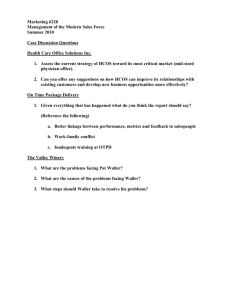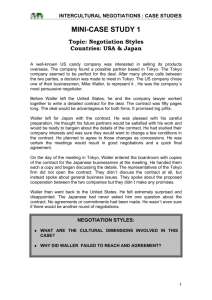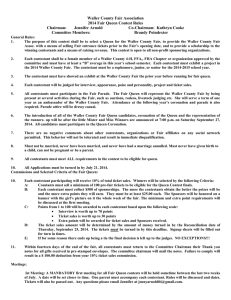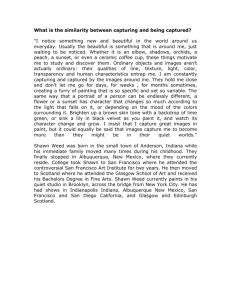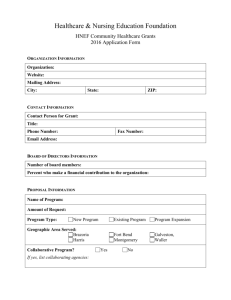School as a Site for Social Change
advertisement
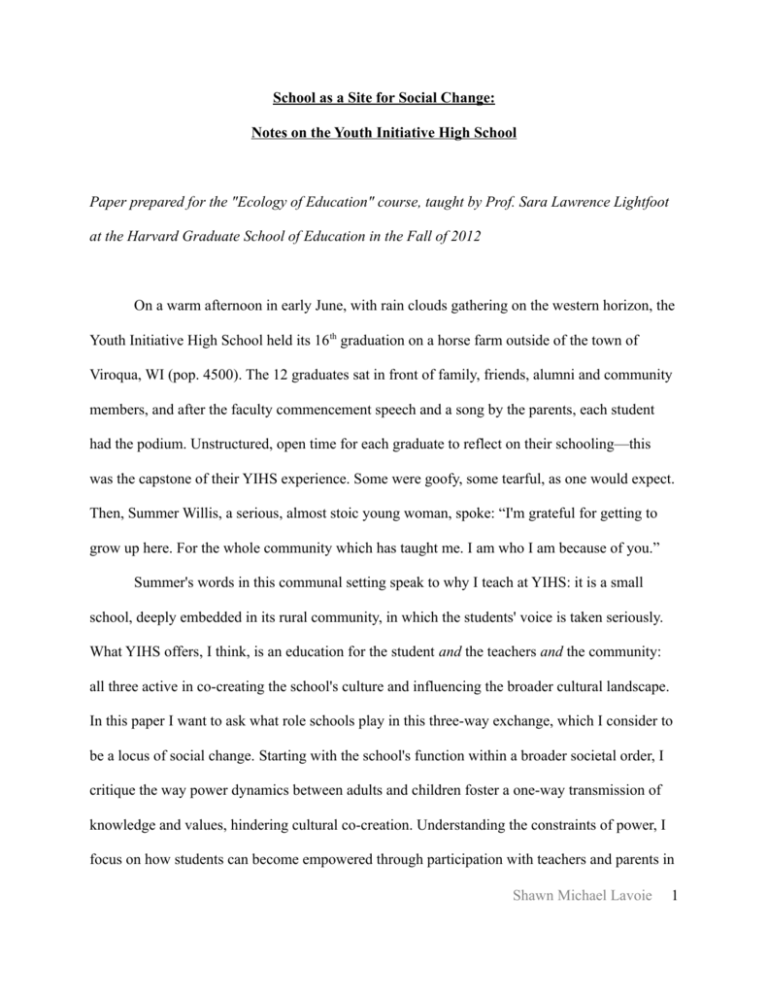
School as a Site for Social Change: Notes on the Youth Initiative High School Paper prepared for the "Ecology of Education" course, taught by Prof. Sara Lawrence Lightfoot at the Harvard Graduate School of Education in the Fall of 2012 On a warm afternoon in early June, with rain clouds gathering on the western horizon, the Youth Initiative High School held its 16 th graduation on a horse farm outside of the town of Viroqua, WI (pop. 4500). The 12 graduates sat in front of family, friends, alumni and community members, and after the faculty commencement speech and a song by the parents, each student had the podium. Unstructured, open time for each graduate to reflect on their schooling—this was the capstone of their YIHS experience. Some were goofy, some tearful, as one would expect. Then, Summer Willis, a serious, almost stoic young woman, spoke: “I'm grateful for getting to grow up here. For the whole community which has taught me. I am who I am because of you.” Summer's words in this communal setting speak to why I teach at YIHS: it is a small school, deeply embedded in its rural community, in which the students' voice is taken seriously. What YIHS offers, I think, is an education for the student and the teachers and the community: all three active in co-creating the school's culture and influencing the broader cultural landscape. In this paper I want to ask what role schools play in this three-way exchange, which I consider to be a locus of social change. Starting with the school's function within a broader societal order, I critique the way power dynamics between adults and children foster a one-way transmission of knowledge and values, hindering cultural co-creation. Understanding the constraints of power, I focus on how students can become empowered through participation with teachers and parents in Shawn Michael Lavoie 1 the policy and rule-making of a school. And lastly I examine how teachers can modify power relations within a school by crossing the boundaries which separate the school from the community. I argue that students and teachers have an equal stake in learning, and that working in concert, they cross the conservative boundaries which limit schools from being potential sites for social change. Drawing on my six years of teaching at Youth Initiative, an independent democratic Waldorf school of 40-50 students, I recognize the bias of my experience and the impossibility of scaling up such a model to meet the needs of all school districts. I also acknowledge that my examples and arguments focus in on dynamic relationships and the agency of individuals, hence setting up a conceptual “leap of faith” to arrive at social change. That said, by exploring the qualities of individuals interacting within schools—teachers and students, teachers and community, and students and community members—I suggest that interactions are a starting place for broader transformation. The limits of one-way transmission Traditionally schools have been sites for transmitting dominant cultural standards— knowledge, values and behaviors—from adults to children. These dominant cultural standards, historically, have reflected the values of a powerful few, and, in certain contexts, were at odds with the lived experience and values of local communities. Willard Waller, in the Sociology of Teaching, sees in schools a battleground at the intersection of the two cultures, “the culture of the society of adults” and “the culture of the group of children” (pg. 104). Teachers, the transmitters of the dominant culture, impose knowledge and skills that often conflict with those learned at home by children. In this clash, Waller recognizes the messiness and tensions involved in teaching and learning and the inherent inequality of power. The tension creates, for Waller, a Shawn Michael Lavoie 2 “curious melánge” of cultural practices in schools, in some ways a hodgepodge culture of its own (pg. 107). But Waller stops short of proposing that schools could be sites for the cultural cocreation; for the sake of institutional order, the authority of the teachers necessarily must win out. Although I critique this one-way transmission, I agree with Waller about the inherently conflictual dynamic between students and teachers. For Waller, “a school exists wherever and whenever teachers and students meet for the purpose of giving and receiving instruction” (pg. 6). Schools then are defined by the their interactions. This definition provides a foundation—the conflictual relationship between teachers and students—from which to analyze the dynamics of learning and cultural exchange. Learning in schools plays out within a highly contested “political order”, and the best schools, according to Waller, are places where both teachers and students believe they have a “real voice in the conduct of school affairs” (pg. 9). Waller, though, is very skeptical of experimental schools which claim that students and teachers have equal say, as he believes the “authority principle”, which is required to maintain school order and the dominance of adults, will always reign in times of conflict. If the transmission of knowledge, values and skills is constrained within power relations, then how schools manage the power differential between students and teachers will play role in the quality of cultural exchange. Youth Initiative accounts for the potential conflict between dominant culture and the culture of kids by making the students, the faculty and the parents voting members of the organization. All three bodies—parents, students and faculty (including administration)— participate in the policy-making process and must interact and find compromise in order to ratify new rules. Youth Initiative alters Waller's “authority principle” by equalizing formal power within the school. However, just because students have the same vote as the faculty doesn't mean Shawn Michael Lavoie 3 there is no conflict over authority. For example, when the school's policy on technology use came up last year, there was a heated debate between and among parents, teachers and students, all taking different positions along the spectrum from no-tech in schools to anything goes. Equal power meant that agreement needed to be brokered: students and teachers debated, faculty spoke at the parent meetings, and committees like the Administrative Group, which has representation from all three bodies, took up the task of drafting a policy. Tension still reigned, but the risk of disorder and the school falling apart from not reaching an agreement—the risk that the adults in Waller's school model held alone—is equally shared. Individual agency within school culture Switching from Waller's social systems perspective with its emphasis on maintaining social order to a phenomenological frame, I want to locate the role of the individual within the cultural battleground of school. As Professor Lawrence Lightfoot described in class, the phenomenological frame attempts to locate the autobiographical within the social structure (lecture 9/12/12). The strength of this approach is that it allows for a more nuanced picture of how an individual navigates and alters a particular social terrain. Moreover, this frame highlights the “shared creativity of individuals” in forming the social life of schools (lecture 9/12/12). Uncovering how individuals collectively create school culture will illuminate how schools can effect social change. Professor Lawrence Lightfoot, referring to the work of Urie Bronfenbrenner, described how an individual “restructures the milieu in which he or she resides” (lecture 9/12/12). Recalling Waller, the “political order” of schools constrains an individual's ability to restructure, which is perhaps why theorists like Henry Giroux, Paulo Freire and Christopher Lasch see schools as unproductive and heartless educational settings (lecture 9/5/12). In order for individuals to Shawn Michael Lavoie 4 exercise agency within schools, schools need to attend to their “political order” and modify the power dynamics that restrict full engagement. Learning about power as empowerment In the middle of December in an after-school Administrative Group meeting, I remember sitting across from Summer and most of the senior class. I remember the tense silence after they finished presenting their proposal for a senior independent study class. We had turned down their first proposal the week before because a) independent study classes are usually proposed by individuals or in pairs, b) their class plan lacked specificity, and c) the class as a whole was having issues with attendance and timeliness. In the intervening week seniors met during lunch to fume together and to edit their proposal, and several seniors came to talk to me and other teachers in our office. Two other teachers, the administrator, two students, a parent, and I composed the Administrative Group, and our reactions to this second proposal were mixed. We liked the improved specificity of their class plans and how they proposed to evaluate each other during the course. But a few of us were not excited about letting the tardy-prone group meet without supervision. “Don't you trust us?” one senior deplored. “Actually, when it comes to showing up on time, no.” Having conversations with teenagers about expectations, rules, and consequences can be very uncomfortable for adults. This was such a moment for me. But I held to my belief that the school needed to maintain a certain level of rigor in its courses. I explained that to them. And after an hour or so, the meeting adjourned with the senior independent study approved, with the proviso that a teacher would take attendance at the start of every class. In many schools these types of conversations don't occur: rules are unbendable and students have no recourse to amending them. Many would consider such a conversation to be a Shawn Michael Lavoie 5 waste of time, or at best, they would see it as outside of the real curriculum. But I argue that this conversation was as central to the learning for the seniors' independent study as the class itself: they had to learn how to negotiate with others, clarify their ideas, understand the rules, argue for something they wanted, and accept some constraints. They had to learn about power. Since teachers and administrators assume total control of most schools, students do not have the opportunity to participate in the policy or rule-making process. They learn to follow school rules obediently, perhaps while being introduced to righteous rule-breakers like Mahatma Ghandi or Martin Luther King Jr. in their history class. Critiquing the disciplining and knowledge-transfer functions of schools, Theodore Sizer, in Horace's Compromise, sees schools as potential training grounds for students' character. He points out that teenagers are “trying to discover their own rules and those of others” (pg. 85). This need to discover and push the rules, highlighted in the YIHS seniors' independent study example, “can be ignored or confronted which takes time and imagination” (pg. 85). Unfortunately, many schools don't allocate the time or imagination to attend to this essential area of discovery. Again recalling Waller, the “authority principle” doesn't allow for such subversive conversations, as they undermine the very basis of order in schools, putting the system in peril. Sizer calls for more “essential schools”, which eschew the standard comprehensive curriculum. Instead of the “mediocre sameness” of the comprehensive model, Sizer believes that students learn best when presented with complex, sometimes ambiguous, open-ended problems (pg. 7). Negotiating and discovering rules, I contend, falls into this category of open-ended problems. The reforms that Sizer suggests move schools closer to being sites of social change than the stodgy “secular church” he sees them as (pg. 6). In his vision students learn basic competencies in core subjects, but most importantly, they learn how to learn for themselves, how Shawn Michael Lavoie 6 to inquire and express themselves, and how to be decent people. Sizer encourages explicit debates on difficult issues faced within the school, claiming that transparency on such issues leads to character development of students (pg. 121). Furthermore, these debates, especially when they can bring the students, teachers and parents together, are crucial to a sense of collective agency and creativity. What students learn when they have direct experience with policy making and power has an effect on the culture of the school. In Professor Lawrence Lightfoot's lecture on culture, she discussed Edgar Schein's book Organizational Culture. In his three-part analysis of culture, espoused and enacted values play a central role in mediating between the visible artifacts of an organization's culture and the invisible assumptions that frame an organization's outlook. For Schein, “values develop as problems are solved”: a solution which works over time becomes invested with special significance (lecture 10/17/12). If students, along with parents and teachers, participate in solving problems that arise in the school—be they behavioral, curricular or budgetary—they then play an active role in creating the values of the school. What they learn in engaging with these open-ended, ambiguous, potentially hot issues, is deeply felt and widely applicable to their present and future life. The process of learning in this way could rightfully be called empowerment. Teacher as a learner and boundary crosser For schools to incorporate students and parents into its policy making processes, teachers (and administrators) need to ceed their absolute authority. Yet if a school opens itself to the melee of multiple voices and open-ended problem solving, teachers will be necessary to hold the structure together, to help arbitrate conflict and advance learning. Following Professor Lawrence Lightfoot's discussion of the shifting images of teachers in public discourse, I see teachers who Shawn Michael Lavoie 7 can work in such an environment as “potentially powerful” (lecture 10/3/12). Their power comes from their intimate connection and knowledge of the students and the communities in which they work. In schools that strive towards social change, teachers cross ecological boundaries and model learning. As a teacher, what assures me that everything is under control is my course syllabus. Come what may, I know that I know where the class is going. But what I've learned is that the best teaching doesn't come from excellent plans, but inspired deviations. For my spring English block with the sophomores, the week before the start of class, I was leaning towards Shakespeare's Julius Cesar, a failsafe classic. That weekend I heard from my friend, a reporter for the local community radio station, that they were looking for local stories, especially from young people. On Monday I came to class with an unfinished syllabus. I told the students that we were going to do journalism, that we had a real deadline. As a class we came up with topics of local interest and decided on the theme of graduation. We considered our audience, what would make a balanced story, and how we were going to get the information we needed. Each student conducted interviews in the radio station studio and learned how to digitally edit their stories, which were aired in the evening of the last day of class. Embracing the uncertainty inherent in teaching is a risky proposal, but one that is full of potential. Given the multiple cultural borders that students traverse in their daily lives, teachers need to embrace intellectual and social border crossing too: teachers need to model learning. In the sophomore journalism block, I crossed out of the realm of standard school curriculum into the local community. By having the radio station deadline as their class deadline, the students had to cross that border as well. The project invited a kind of learning which was both academically rigorous (their news stories were their best writing all year) and socially salient (people besides Shawn Michael Lavoie 8 their own parents listened and learned something). But what I think is more important than either the classroom learning or the community impact is the practice of crossing boundaries, from the school to the community, from kids to adults, from friends to strangers, from the known to the unknown—for both the student and teacher. I want to emphasize that students, like teachers and parents, cross boundaries everyday— their home, culture of origin, peers, pop culture, street culture—and a school that denies the cross-disciplinary nature of students' lives misses out on many opportunities for profound learning. Recognizing the complexity of students' lives, George Dennison in The Lives of Children tells the story of the First Street School, an experimental school, which saw itself less as a place than as a set of dynamic relationships, between teachers and students, teachers and teachers, and students and students. Dennison writes, “the proper concern for the primary school is not education in the narrow sense, and still less preparation for later life, but the present lives of children” (pg. 9). In his many examples of significant student breakthroughs, Dennison underscores that the “present lives of children” are very complicated, involving troubled homes, traumatic pasts, and dangerous neighborhoods. The role of the teacher then is to attend to the student in all his or her complexity, and to “trust that some organic bond [exists] between the wishes of the children and their actual needs” (pg. 21). This respect that Dennison describes challenges Waller's perception of teachers as necessarily aloof and condescending and the popular perception of teachers as deliverers of knowledge. What I take from Dennison is a call for teachers to respect the fullness of the student's lives outside of school, while also making school a safe and challenging space for students to meet their needs and grow. What makes a good teacher, one who can hold together the kind of school that has the potential to change society, is one who can put these ideals—teacher as a boundary crosser and Shawn Michael Lavoie 9 learner—into practice. And this, of course, is the hardest part. In her lecture on the roles of the theorist and the practitioner, Professor Lawrence Lightfoot pointed to the interdependence of theorist and practitioner, of idea and practice (lecture 9/19/12). But what constrains the freeflowing interplay of ideas and practice is fixed institutional power. For a teacher to put these ideas into practice, he or she needs not only the support from the school administration and the parents but their collaboration. For schools to become more than just a set of great ideals—Sizer's “secular church”—they have to change their practice at a foundational level. At the ground level is a teacher, who is willing to take lessons across ecological borders and to learn with his students in their “present lives.” Conclusion: Why has humanistic education flopped? The type of school I am describing could fall in the broad category of humanistic eduction (lecture 10/10/12). The core of humanistic education is the individual student and his or her full development. This ideal is scripted into the mission statements of many schools, including YIHS, yet, as Professor Lawrence Lightfoot noted in class, humanistic education lives longer in rhetoric than in practice (lecture 10/10/12). This focus on individual fulfillment crumbles under the dominant educational value system, the managerial, which, like Waller, focuses order and producing students who are ready for the adult society. Is the kind of school I've depicted, which is a site for the cultural co-creation, the practice of empowerment and learning across boundaries, doomed to follow the failure of humanistic education? Maybe. But maybe not. Recalling how Summer recognized of the importance of the community in shaping her education, I am reminded that she grew up in the dynamic interplay of others—Bronfenbrenner's mutually constructive ecology of human development (lecture Shawn Michael Lavoie 10 9/12/12). This co-construction is perhaps what is missing in many humanistic schools. By addressing its own power dynamics, a school opens itself to a vibrant exchange between students, teachers and parents in which all three are affected. These interactions can be messy and tense, but if attended to well, they can also inspire individuals to learn: individuals to affect other individuals: and in doing so, to change the social world. Works Cited Waller, W. (1965). Sociology of Teaching. John Wiley & Sons Inc (April 1965) Sizer, T. (1992). Horace's Compromise. Mariner Books. Dennison, G. The Lives of Children. Schein, E. (2010). Organizational Culture. Jossey-Bass. Shawn Michael Lavoie 11
